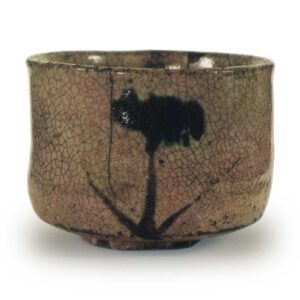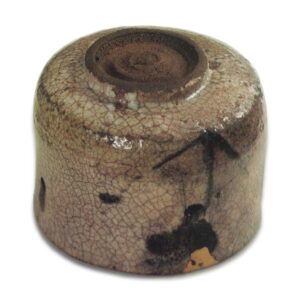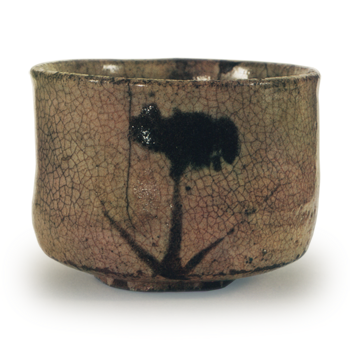

Height: 8.7 to 9.1 cm
Diameter: 11.8 to 12.2 cm
Outer diameter of foot ring: 6.1 to 6.4 cm
Height: 0.7 cm
The number of Edo-period Karatsu ware pieces that have survived is quite large. Although they were only produced for a short period of time, from the end of the Momoyama period to the beginning of the Edo period, the number of pieces that have survived is considerable, and if you visit the sites of the kilns and look at the fallen pottery fragments, you can see that they were mass-produced.
However, when it comes to famous bowls, there are very few of them. The Karatsu tea bowls that have been highly prized since ancient times, such as Okukoma, Korekan, and Nakao, are all plain. The reason that there are no famous bowls among the painted Karatsu is probably because there is nothing like a plain tea bowl.
This tea bowl, which depicts a single iris stalk on the body, is the most famous of the E-Karatsu tea bowls, and has been published in most pottery books published since the end of the war. The irises are painted on both sides of the body using iron pigment, and the simple, elegant style is irresistible. It is rare for a piece of Ekaratsu ware to have such a profound effect on us.
The clay is a rough soil mixed with small sand, and it is well-fired and hard. It is covered in a thick, translucent feldspar glaze similar to Shino, and there are rough cracks all over the surface.
The rim is slightly bulging, the body is almost straight, and it has a low, large foot ring. It is thickly made and heavy. The flat interior and the heavy weight are the main drawbacks of this tea bowl, but the iris pattern on the body more than makes up for this. In particular, the black flowers mixed with the thick glaze create a deep tone that is unlike anything I have ever seen before.
The bottom is open to the air, revealing the rough clay, and it is stained a dark color by tea stains, but it was probably originally a light grayish-white clay. A helmet-shaped crest stands in the center of the bottom, and around it there are not concentric circles, but two sets of raised circles.
Of the nearly 200 Karatsu kilns, many of them produced E-Karatsu. The famous Ekaratsu kilns include Doen, Aboya, Kameyadani, Yakiyama, Fujinokawachi, Koraidani, Ichinoseyama, Satsunomoto, Yanaginomoto, Komizoyama, and Risyoko, but looking at the clay and glaze, I think this tea bowl is from the Iidomikama kiln in Kishidake. It is not clear whether it was made in the Bunroku or Keicho periods, but it is certain that it was made in the Genwa period at the latest.
There are four gutters around the rim, one of which extends down to the waist. It looks like it has been used a lot, and the glaze on the outside of the rim and the waist has flaked off, revealing the clay. There is one break on the rim, which has been repaired with gold, but it is a famous bowl that is widely known as a picture Karatsu.



